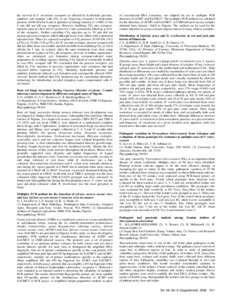| dc.contributor.author | Aigbe, S.O. |
| dc.contributor.author | Remison, S.U. |
| dc.contributor.author | Bandyopadhyay, Ranajit |
| dc.date.accessioned | 2019-12-04T11:15:10Z |
| dc.date.available | 2019-12-04T11:15:10Z |
| dc.date.issued | 2008 |
| dc.identifier.citation | Aigbe, S.O., Remison, S.U. & Bandyopadhyay, R. (2008). Root rot fungi succession during Cassava (Manihot esculenta. Crantz) tuberous root development in different ecological zones of Nigeria. Phytopathology, 98(6), 1. |
| dc.identifier.uri | https://hdl.handle.net/20.500.12478/2929 |
| dc.description.abstract | Root rot fungi succession during cassava tuberous root development was
investigated in Ibadan (Derived savanna), Sabongidda-Ora and Onne (Humid
forests) of Nigeria. Two improved cassava varieties (TMS 30572 and TMS 4
(2) 1425) and one local (TME-1) were planted in a randomized complete
block design with 3 replications. Isolation of associated fungi was done from
tuberous and fibrous root samples collected at 3, 6, 9 and 12 months after
planting (MAP). Six species (Fusarium solani, Fusarium oxysporum,
Botryodiplodia theobromae, Trichoderma harzianum, Rhizopus stolonifer,
Aspergillus niger) and one unknown fungus were isolated frequently from
growing roots. A clear relationship was demonstrated between growth stage,
location, fungal succession and root rot incidence/severity. During the two
planting seasons of this study and also throughout all locations, fibrous roots
generally supported more diversity and higher frequencies of fungal
growth than the tuberous roots. Fusarium oxysporum was usually an early to
mid stage colonizer of root tissue while B. theobromae was a late
colonizer. Botryodiplodia theobromae and F. solani were normally absent or
rare during dry season periods at 6 MAP but re-emerged when rainy season
resumed at 9 MAP till 12 MAP. Fusarium oxysporum dominated during the
dry season period at 6 MAP. In the trial, local TME-1 genotype was the most
colonized while improved TMS 4(2)1425 genotype was least colonized. In
Ibadan and Sabongidda-Ora during the first planting season, F. solani was the
most prevalent colonizer while B. theobromae was the most prevalent in
Onne. |
| dc.language.iso | en |
| dc.subject | Tuberous Roots |
| dc.subject | Fibrous Roots |
| dc.subject | Fusarium Oxysporum |
| dc.subject | Prevalent Colonize |
| dc.subject | Botryodiplodia Theobromae |
| dc.subject | Genotypes |
| dc.subject | Cassava |
| dc.title | Root rot fungi succession during cassava (Manihot esculenta. Crantz) tuberous development in different ecological zones of Nigeria |
| dc.type | Manuscript-unpublished |
| dc.description.version | Peer Review |
| cg.contributor.affiliation | Ambrose Alli University |
| cg.contributor.affiliation | International Institute of Tropical Agriculture |
| cg.coverage.region | Africa |
| cg.coverage.region | West Africa |
| cg.coverage.country | Nigeria |
| cg.authorship.types | CGIAR and developing country institute |
| cg.iitasubject | Plant Production |
| cg.iitasubject | Plant Diseases |
| cg.iitasubject | Plant Breeding |
| cg.iitasubject | Post-Harvesting Technology |
| cg.iitasubject | Plant Genetic Resources |
| cg.iitasubject | Livelihoods |
| cg.iitasubject | Pests Of Plants |
| cg.iitasubject | Food Security |
| cg.iitasubject | Genetic Improvement |
| cg.accessibilitystatus | Limited Access |
| local.dspaceid | 94030 |

